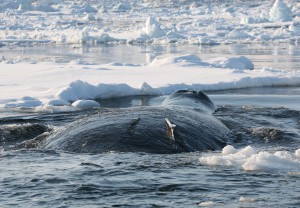 Bowhead whales congregate in Disko Bay, West Greenland, in winter and spring in order to take advantage of high quality feeding opportunities, finds a new study published in Animal Biotelemetry today. The whales diving behaviour differs between winter and spring months, matching the seasonal changes in availability of copepods nearer the surface.
Bowhead whales congregate in Disko Bay, West Greenland, in winter and spring in order to take advantage of high quality feeding opportunities, finds a new study published in Animal Biotelemetry today. The whales diving behaviour differs between winter and spring months, matching the seasonal changes in availability of copepods nearer the surface.
By tagging nine Bowhead whales (Balaena mysticetus) in Disko Bay with satellite telemetry tags and archival GPS tags, Heide-Jørgensen from the Greenland Institute of Natural Resources, and colleagues have uncovered the winter and spring feeding behaviour of these secretive animals. While the whales spent similar amounts of time foraging in each season, there was a significant difference in the depth of ‘U-dives’, which means that they are feeding at different depths in winter and spring. The mean maximum depth of U-dives in winter was 342m, compared with approximately 184m in spring. The authors correlate this change in behaviour with the abundance of copepods in diapause near the sea floor in winter and the ascension of copepods towards the surface during spring.
at different depths in winter and spring. The mean maximum depth of U-dives in winter was 342m, compared with approximately 184m in spring. The authors correlate this change in behaviour with the abundance of copepods in diapause near the sea floor in winter and the ascension of copepods towards the surface during spring.
Interestingly, the whales then leave Disko Bay at the end of the spring, and therefore miss out on the peak abundance of copepods at the surface. This suggests that this area is less ideal foraging for the whales later in the year, possibly due to the density of copepods at the surface being too low, or insufficient caloric value of the copepods in summer – copepods have a higher caloric value in winter due to oil stored during diapause.
Latest posts by Rhiannon Meaden (see all)
- Guinea pig teenagers are highly domesticated - 9th April 2014
- Goats, the boffins of the farmyard - 26th March 2014
- Developments in Daphnia - 25th March 2014
Comments